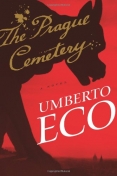BKMT READING GUIDES
The Prague Cemetery
by Umberto Eco
Hardcover : 464 pages
0 club reading this now
0 members have read this book
“Vintage Eco . . . the book is a triumph.” – New York Review of Books
Nineteenth-century Europe—from Turin to Prague to Paris—abounds with the ghastly and the mysterious. Jesuits plot against ...
Introduction
“Vintage Eco . . . the book is a triumph.” – New York Review of Books
Nineteenth-century Europe—from Turin to Prague to Paris—abounds with the ghastly and the mysterious. Jesuits plot against Freemasons. Italian republicans strangle priests with their own intestines. French criminals plan bombings by day and celebrate Black Masses at night. Every nation has its own secret service, perpetrating forgeries, plots, and massacres. Conspiracies rule history. From the unification of Italy to the Paris Commune to the Dreyfus Affair to The Protocols of the Elders of Zion, Europe is in tumult and everyone needs a scapegoat. But what if, behind all of these conspiracies, both real and imagined, lay one lone man?
“[Eco] demonstrates once again that his is a voice that compels our attention” – San Francisco Chronicle
“Choreographed by a truth that is itself so strange a novelist need hardly expand on it to produce a wondrous tale . . . Eco is to be applauded for bringing this stranger-than-fiction truth vividly to life.” – New York Times
“Classic Eco, with a difference.” – Los Angeles Times
Editorial Review

Dear Amazon Readers:
The nineteenth century teemed with mysterious and horrible events: the Protocols of the Elders of Zion, the notorious forgery that later inspired Hitler; the Dreyfus Case; and numerous intrigues involving the secret services of various nations, Masonic sects, Jesuit conspiracies, as well as other episodes thatâ??were they not documented truthsâ??would be difficult to believe.
The Prague Cemetery is a story in which all the characters except oneâ??the main characterâ??really existed. Even the heroâ??s grandfather, the author of a mysterious actual letter that triggered modern anti- Semitism, is historical.
And the hero himself, though fictional, is a personage who resembles many people we have all known, past and present. In the book, he serves as the author of diverse fabrications and plots against a backdrop of extraordinary coups de théâtre: sewers filled with corpses, ships that explode in the region of an erupting volcano, abbots stabbed to death, notaries with fake beards, hysterical female Satanists, the celebrants of black Masses, and so on.
I am expecting two kinds of readers. The first has no idea that all these things really happened, knows nothing about nineteenth-century literature, and might even have taken Dan Brown seriously. He or she should gain a certain sadistic satisfaction from what will seem a perverse inventionâ??including the main character, whom I have tried to make the most cynical and disagreeable in all the history of literature.
The second, however, knows or senses that I am recounting things that really happened. The fact that history can be quite so devious may cause this readerâ??s brow to become lightly beaded with sweat. He will look anxiously behind him, switch on all the lights, and suspect that these things could happen again today. In fact, they may be happening in that very moment. And he will think, as I do: "They are among usâ?¦"
--Umberto EcoDiscussion Questions
No discussion questions at this time.Book Club Recommendations
Recommended to book clubs by 0 of 0 members.
Book Club HQ to over 90,000+ book clubs and ready to welcome yours.
Get free weekly updates on top club picks, book giveaways, author events and more








